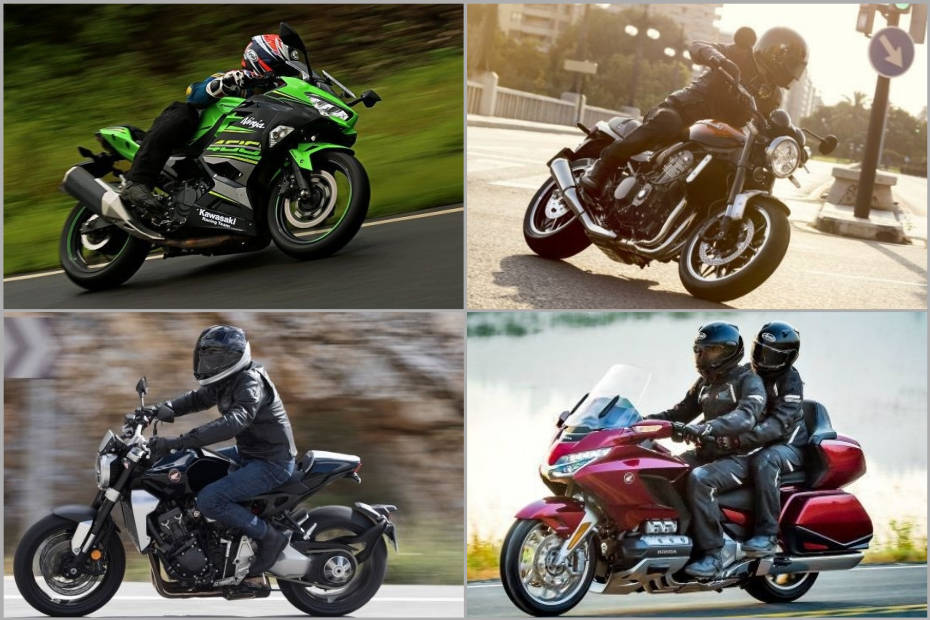Top 4 Bikes That Came To India From 2017 Tokyo Motor Show
Published On Oct 19, 2019 01:41 PM By Praveen M.for Kawasaki Ninja 400
- 1345 Views
We take a stroll down memory lane to see how the previous edition of the Tokyo Motor Show was relevant for the Indian market

The 2017 edition of Tokyo Motor Show witnessed quite a few interesting two-wheelers and we believe the action is all set to be dialled up even further at this year’s edition. Granted most of these motorcycles were all pretty high-end, but ultimately some of them ended on our shores, delighting enthusiasts. Here’s a recap of all the important motorcycles, which made their debut at the previous edition before making their way to India:
Kawasaki Ninja 400:

Kawasaki wanted to replace the ageing Ninja 300 with a more powerful motorcycle capable of passing future emission norms. Thus, the Ninja 400 came into existence. After debuting at the Tokyo Motor Show, the bike entered India in April 2018. Interestingly, this motorcycle served as the perfect middle ground between the heavily localised Ninja 300 and the Ninja 650 in the Indian market
While we were expecting competitive pricing, Kawasaki disappointed us with a steep Rs 4.69-lakh price tag. Last month, the brand launched the 2019 iteration with new colour schemes and the bike now costs Rs 4.99 lakh (ex-showroom). Make no mistake, the bike is a brilliant performer with a creamy parallel-twin engine and capable underpinnings and dynamics. However, its price tag simply didn’t justify for what’s essentially a 400cc motorcycle. Ironically though, this is the most affordable motorcycle in this list as the rest of the bikes cater to the segments above this one.
Kawasaki Z900RS:

We were pretty excited when Kawasaki teased a neo-retro offering and went totally gaga over the debut of the Z900RS at the 2017 Tokyo Motor Show. The motorcycle reeked of nostalgia thanks to the design genes from the iconic 1972 Kawasaki Z1 Super Four 900. Under the facade of such design lied properly modern powertrain and underpinnings. The motorcycle shares its powerplant with the Z900 but it has been tuned to make the peak torque and power earlier down the rev range. Also, the peak power is down from 125PS in the Z900 to 111PS in Z900RS. However, the peak torque is pretty much the same at 98.5Nm.
Kawasaki figured the premium neo-retro space isn’t as popular as other segments and decided to bring the bike via the CBU route from Japan in February 2018. This made it ridiculously expensive at Rs 15.7 lakh (ex-showroom). The high pricing wasn’t a sound business move as the CKD Z900 (on which the RS is based) costs ‘only’ Rs 7.69 lakh (ex-showroom India), which is less than half of the Z900RS’ cost!
Honda Gold Wing DCT:

Honda’s popular luxury tourer, the Gold Wing was due for an update for a long time and the brand decided to bless the venerable mile-muncher with a complete overhaul and the all-new version made its debut at the 2017 Tokyo Motor Show. It featured sharper styling, properly sophisticated underpinnings, revised engine internals, and futuristic electronics and multimedia system. It even has a reverse gear to pull the 379-kilo (kerb) motorcycle from tight parking spots.
However, the icing on the cake is its DCT gearbox. There’s no clunky clutch or gear lever. You can simply shift gears at the touch of a button. What’s more, there’s even a crawl mode for low-speed manoeuvres. The Gold Wing DCT was launched in India in December 2017, and at Rs 27.7 lakh (ex-showroom India), it offers pretty good value for money in the luxury touring segment.
Special mention: Honda CB1000R:

Honda had only unveiled the Neo Sports Cafe concept at the 2017 Tokyo Motor Show. However, the production version—CB1000R was shortly unveiled a couple of weeks later—at the 2017 EICMA show. It looked radically different from the previous-generation CB1000R, which looked like any other run-of-the-mill naked. The neo-retro motorcycle packs a new frame and a potent 998cc inline four-cylinder engine with a healthy 145PS and 104Nm on tap.
While it may look retro, the bike is loaded with properly modern features such as LED lighting system and LCD instrument console. It is also loaded with assorted electronic nannies such as three-level traction control, three-level engine brake and engine power, and three riding modes. Honda knows Indian riders’ affinity towards top-of-the-line models and hence launched only the CB1000R+ in India in December 2018. This variant is essentially a full-loaded factory-fitted accessories version of the standard model. It comes with a standard quickshifter, pillion seat cowl, heated grips and radiator guard to name a few.
